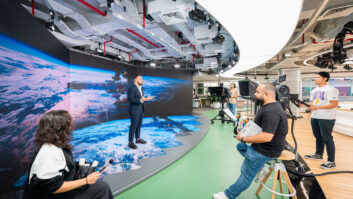 Since Tim Cook’s announcement about the Apple Vision Pro back in June, there has of course been a lot of excitement about the launch of the world’s first spatial operating system, visionOS. Aside from the hype and anticipation surrounding the launch, it didn’t go unnoticed that Apple made no reference to the metaverse. This wasn’t surprising given that Tim Cook has been rather vocal about how he doesn’t think it’s the future. Public and industry opinions about the metaverse, or the “m word” as it has come to be called, have always been mixed, and many immersive technology providers avoid using the term altogether. And when Microsoft and Disney announced the closure of their metaverse divisions earlier in the year, it only served to reinforce the feeling that there is a lack of enthusiasm or viability for the metaverse.
Since Tim Cook’s announcement about the Apple Vision Pro back in June, there has of course been a lot of excitement about the launch of the world’s first spatial operating system, visionOS. Aside from the hype and anticipation surrounding the launch, it didn’t go unnoticed that Apple made no reference to the metaverse. This wasn’t surprising given that Tim Cook has been rather vocal about how he doesn’t think it’s the future. Public and industry opinions about the metaverse, or the “m word” as it has come to be called, have always been mixed, and many immersive technology providers avoid using the term altogether. And when Microsoft and Disney announced the closure of their metaverse divisions earlier in the year, it only served to reinforce the feeling that there is a lack of enthusiasm or viability for the metaverse.
Is all of this an indication that the metaverse has reached the end of the road? Or is Apple’s new offering instead delivering to the video industry exactly what it needs to progress the metaverse, by bridging the gap between the physical and digital world? Is it a case of semantics where the concept is still progressing and evolving yet under a different guise?
Defining a vision
The metaverse has always meant different things to different people, and as is often the case with visions, it’s difficult to pin it down. At the most basic level, it’s a shared virtual world. Its abstract nature is perhaps one of the reasons why it’s been so difficult to convert the masses. Although the concept hasn’t achieved widespread buy in, let’s not forget that there are some real metaverse successes out there right now. Fortnite and Roblox are both highly successful examples of a metaverse where people ‘go’ to a virtual world to play games, interact with others, and socialise.
Niantic, the company behind Pokemon Go, also deserves a mention. Its platform, Niantic Lightship, which is a kind of version of the metaverse but for the real world, is very successful. Niantic has a very positive and unique way for users to interact with technology, taking them out of their homes, and connecting them to the real world, and to other people. There are also VR metaverses but these have had less traction, probably because of the low amount of devices available.
So where does Vision Pro leave the metaverse vision? Rather than creating an entirely virtual world, it promises to deliver an unprecedented level of immersion, seamlessly blending digital content with physical space. With Vision Pro, Apple is giving us a stepping stone to the new technology of spatial computing (and XR), using the apps we are familiar with, such as Safari, photos, Facetime, and AppleTV+. The socialising element will grow over time and will lead us to something similar to a metaverse in the future. This is very much a long-term vision.
Semantics versus substance
So has the metaverse reached the end of the road, or are we just not ready for it yet? While Meta has been clear in setting out its vision, people don’t see the use yet because it’s difficult to understand. Apple’s Vision Pro, while not marketed as having any connection to the metaverse, embodies several key elements of the concept. Alongside spatial computing and AR, it uses VR to enable users to become immersed in apps and digital content. Sound familiar? By simplifying the technology, Apple is giving people something they want to use because they understand it. It’s possible that Apple’s offering may, in fact, be a significant step toward realising the long term vision of the metaverse.
Spatial computing is undoubtedly going to revolutionise how we all interact with technology. VisionOS’s ability to map digital elements onto the real world could provide the foundation for an immersive, interconnected universe. Just as technology, clothes and music go out of fashion, so do words. While Apple did not use the term ‘metaverse’, it is still focusing on delivering immersive experiences.
Even if the term ‘metaverse’ has reached the end of the road, I personally think that we’re witnessing the evolution of the concept, rather than its demise. The path forward will be marked by spatial computing and XR, but it’s too early to say how all these technologies will converge in the future and how comfortable people will be to interact with other people in virtual environments. As technology continues to advance, the concept of a shared digital universe remains a tantalising possibility. But while sharing a virtual beer in a virtual bar is not likely to become commonplace tomorrow, the blending of physical and digital worlds using XR technologies is already here. visionOS is just the beginning.







